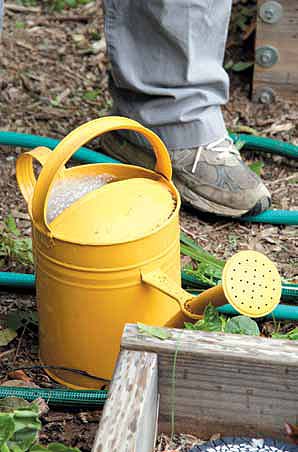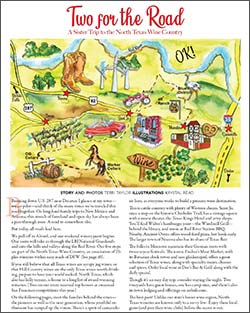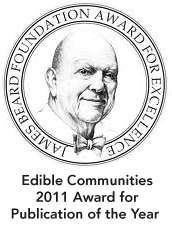
By Howard Garrett
Photo: Katie Ruppel
I once heard a gardening guy on the radio say that you couldn’t garden in North Texas from the middle of August to June. I almost snorted my herb tea through my nose. As any halfway competent gardener knows, just the opposite is true. !e colder months are the perfect time to get the early spring garden under way.
If this is your first garden, here’s how it works. To begin with, find a sunny spot. Take a sample of the existing soil and set it aside. (You’re going to do this again when the bed’s prepared, but more about that later.) When preparing a bed, my favorite shotgun approach is to start by scraping away the existing grass and weeds and tossing them into the compost pile. If you don’t have one, start one. It doesn’t take much space. A ring of welded wire can be used to form the bin. But if you’re in a hurry, compost may also be purchased commercially in bulk and bags.
Apply five to six inches of compost to the entire area. Depth depends on the quality of the compost you have. If using unfinished compost, you need a bit more than if you’re using something of a higher quality, like earthworm castings. High-quality compost is soft and smells like the forest floor. Foul-smelling compost with sand and other identifiable pieces (meaning things that have not yet decomposed) is inferior. If the compost you’re handling leaves your hands smelly, you have some questionable stuff. It will still work, but it takes longer to accomplish the goal, which is creating healthy soil.
Next, add the following amendments (per 1000 square feet): 80 lbs. of zeolite, 40 lbs. of greensand, 40 lbs. of decomposed granite, 20 lbs. of whole ground cornmeal, 20 lbs. of dry molasses and 20 lbs. of organic fertilizer. These materials can be obtained at your local gardening store or from landscape contractors.
When the improved beds are complete, take a second soil test, then send both sets of samples to Texas Plant and Soil Lab in Edinburg, Texas (Go to texasplantandsoillab.com. They will send you a kit that is simple to use. The cost ranges from $18- $55.) The analysis will give you the composition of the original soil and the starting condition of the improved beds. Both will give you excellent data on how to base your fertility program. I recommend Texas Plant and Soil Lab because of their extraction methods, and also because they offer organic solutions. You can produce tasty crops by skipping the soil testing and just doing the basic organic improvements, but the difference in your success will be dramatic (especially in the first year) if you take the time and spend a little money for the tests.
If we have a mild winter, lots of cool season crops can be planted and maintained throughout the entire season. Garden crops can be covered with floating row cover, or if you want to build it—a hoop house, which is like a mini greenhouse. Without question, winter is a good time to plant tough perennial herbs such as comfrey, rosemary, bay, thyme, sweet myrtle and veggies such as radishes, carrots, onions and potatoes. Asparagus and Irish potatoes can be planted in January. Carrots and radishes can be planted almost any month from seeds, and onion transplants (referred to as sets) go out in February. In a mild winter, the foliage will emerge long before the last freeze. Frozen foliage will simply re-grow while the roots continue to grow, and harvest comes earlier as a result.
When crops are covered with floating row cover, damage to foliage can be avoided. The use of this lightweight material gives about four degrees of protection. An organic program also gives up to four additional degrees of protection. How does that work? Healthy soil provides the plants with proper trace minerals, and that relates directly to the complex carbohydrates (sugars) in the plants. They function as antifreeze and also increase the taste and nutritional value of the food.
In closing, my best tip is to drench all plantings after installation with a one-time application of Garrett Juice* and some type of mycorrhizae product. !e formula for Garrett Juice can be prepared by the gardener, or it may be purchased commercially. A mycorrhizae product is a high-tech mix of beneficial bacteria and mycorrhizal fungi and may also be purchased at gardening stores. Organic gardening methods don’t have to be difficult. You’ll find that they are easier than the alternative, and the yield will be great, even in the first year. If you’re a user of toxic chemicals, just give organic a try. Enjoy your gardens and don’t forget to feed the birds. And when admiring beautiful birds flying overhead, keep your mouth shut!
*To find the recipe for Garrett Juice and its variations go to: www.dirtdoctor.com.
Edible Dallas & Fort Worth is a quarterly local foods magazine that promotes the abundance of local foods in Dallas, Fort Worth and 34 North Texas counties. We celebrate the family farmers, wine makers, food artisans, chefs and other food-related businesses for their dedication to using the highest quality, fresh, seasonal foods and ingredients.
- Edible Dallas and Fort Worthhttps://www.edibledfw.com/author/edibledfw/
- Edible Dallas and Fort Worthhttps://www.edibledfw.com/author/edibledfw/
- Edible Dallas and Fort Worthhttps://www.edibledfw.com/author/edibledfw/
- Edible Dallas and Fort Worthhttps://www.edibledfw.com/author/edibledfw/







